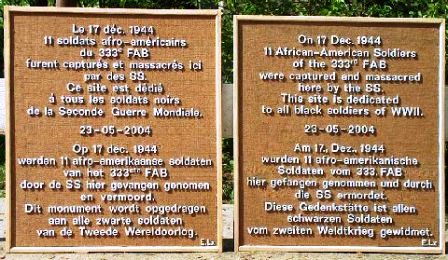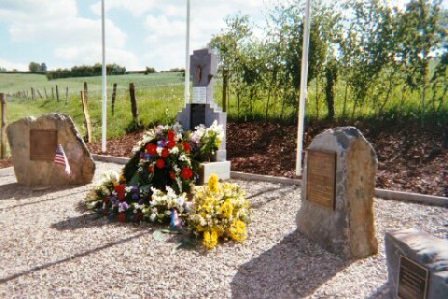Wereth 11 Memorial
Details:
Along the west side of the road. Monument
In the early morning hours of December 16th, German artillery began shelling the Schonberg area. By the afternoon, with reports of rapid German infantry and armored progress, the 333rd Field Artillery Battalion, an Afriacan-American unit, was ordered to displace further west but, at the request of the 106th Div. artillery commander, to leave 'C' Battery and Service Battery in position to support the 14th Cavalry and 106th Infantry Division.
By the morning of December 17th, the Germans were in Schonberg, and in control of the bridge across the river that led to St. Vith. Service Battery tried to displace to St. Vith through the village and were brought under heavy fire. Those not killed were forced to surrender. However eleven men of different Batteries who were caught on the east side of the river went overland in a northwest direction in the hopes of reaching American lines. At about 3 pm, they approached the first house in the nine-house hamlet of Wereth, Belgium, owned by Mathius Langer. A friend of the Langer's was also present.
The men were cold, hungry, and exhausted after walking cross-country through the deep snow. They had two rifles between them. The family welcomed them and gave them food. But this small part of Belgium did not necessarily welcome Americans as "Liberators." This area had been part of Germany before the First World War and many of its citizens still saw themselves as Germans and not Belgians. The people spoke German but had been forced to become Belgian citizens when their land was given to Belgium as part of the First World War repatriations. Unlike the rest of Belgium, many people in this area welcomed the Germans in 1940 and again in 1944, because of their strong ties to Germany. Mathius Langer was not one of these. At the time he took the Black Americans in he was hiding two Belgian deserters from the German Army and had sent a draft age son into hiding so the Nazis would not conscript him.
About 4 pm, a four man German patrol of the 1st SS Division, belonging to Kampfgruppe Knittel arrived in Wereth in their Schwimwagen vehicle. It is believed a Nazi sympathizer informed the SS that there were Americans at the Langer house. When the SS troops approached the house the eleven Americans surrendered quickly, without resistance. The Americans were made to sit on the road, in the cold, until dark. The Germans then marched them down the road. Gunfire was heard in the night. In the morning, villagers saw the bodies of the men in a ditch at the corner of a cow pasture. Because they were afraid that the Germans might return, they did not touch the dead soldiers. The snow covered the bodies and they remained entombed in the snow until January when villagers directed members of the 99th Div. I&R platoon to the site. The bodies had been frozen and unmolested since the massacre The official report noted that the men had been brutalized, with broken legs, bayonet wounds to the head, and fingers cut off.
Seven of the men were buried in the American Cemetery at Henri-Chapelle, Belgium, and the other four were returned to their families for burial after the war ended. Herman Langer, the son of Mathius Langer, who had given the men food and shelter, erected a small cross, with the names of the dead, in the corner of the pasture where they were murdered, as a private gesture from the Langer family on the fiftieth anniversary of their deaths. The current memorial was erected in 2004 is believed that this is the only memorial to Black G.I.s, and their units, of World War II in Europe.
Monument Text:
Adams, Curtis
Bradley, Mager
Davis, George
Forte, Thomas
Green, Robert
Leatherwood, Jim
Moss, Nathaniel
Moten, George
Prittchet, William
Stewart, James
Hier wurden
am 17.12.1944
elf U.S. Soldaten
von der SS
erschossen
English Translation:
Here
on 12/17/1944
11 U.S. soldiers
were shot
by the SS
The plaque on a rock reads in four languages:
On 17 Dec. 1944
11 African-American Soldiers
of the 333rd FAB
were captured and massacred here by the SS.
This site is dedicated to all black soldiers of WWII.
23-05-2004
Commemorates:
People:
Units:
106th Infantry Division
14th Cavalry Group
333rd Field Artillery Battalion
United States Army
Wars:
WWII
Battles:
Battle of the Bulge
Other images :



